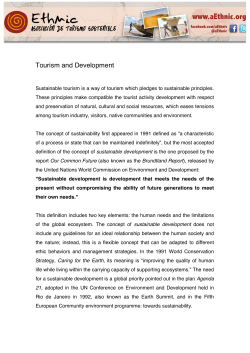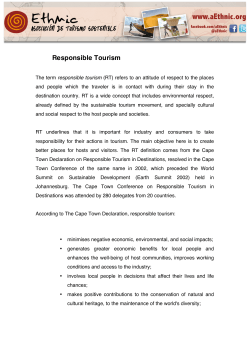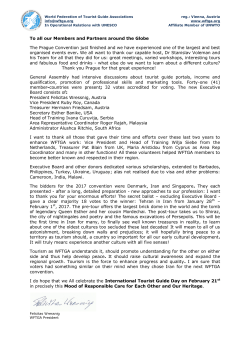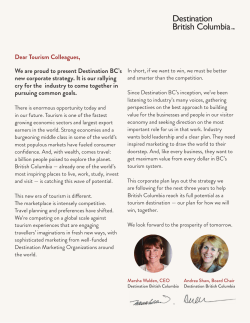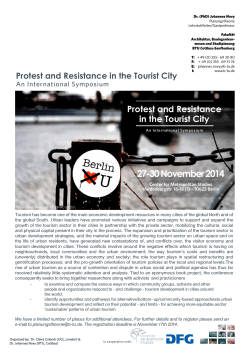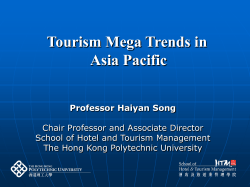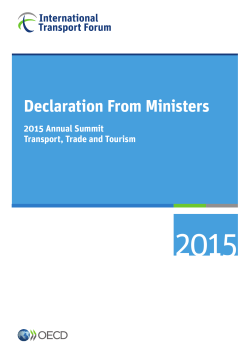
Tourism - ARK Elvin Academy
Tourism In this unit students gain an understanding of how global tourism is changing, why tourist areas need management for continued success, why tourists are looking out even more remote places than ever and whether ecotourism is the way to a more sustainable future for tourism. There are five key ideas in this unit: 1. The global growth of tourism has seen the exploitation of a range of different environments for holiday makers. 2. Effective management strategies are the key to continuing prosperity of tourist areas in the UK. 3. Mass tourism has advantages for an area but strategies need to be in place to reduce the likelihood of long-term damage. 4. Extreme environments are susceptible to environmental damage from the development of tourism. 5. Sustainability requires the development of ecotourism. 1. The global growth of tourism has seen the exploitation of a range of different environments for holiday makers. According to the World Tourism Organisation (WTO), tourism involves activities that require travel away from home and staying away from home for at least one night. This not only includes people going on holiday, but also people taking business trips and/or visiting family and friends. Most people, however, would also include day visits from home to the coast or a National Park under the heading of tourism. Global growth in tourism Tourism is the world's largest industry, worth $500 billion in 2007. Globally, tourism has more than doubled in just 18 years - from 438 million tourists in 1990 to 922 million in 2008. Why has tourism grown? Social and economic factors Improvements in technology Expansion of holiday choice more money: higher wages and more disposable income means more money available to spend on holidays transport: travel today is quicker and easier than ever before as there are more motorways, more airports and faster jet aircraft more destinations: better transport and more money has meant people can travel further and to more places more parents working: most budget airlines: growth of budget ecotourism and the development families have two working parents airlines has meant that flying has of unusual destinations e.g. whereas in the past it was usually become cheaper Antarctica one, this means more money internet: booking a holiday online is less children: less expensive to quick and easy and often cheaper as take a small family away than a you do not need to use a travel agent. large one more leisure time: holiday leave time has increased from two weeks per year in the 1950s to between four and six today. more retired people: life expectancy has risen so there are more retired people who travel Tourist Destinations Many people choose to visit cities to enjoy culture asssociated with museums, art galleries, architecture or shops and restaurants. Cities such as London, Paris and Rome have a huge amount to offer tourists of every age. Major events are also often held in cities and tourists travel to the city to attend the event e.g. London 2012 Olympics. Other cities have unique features that attract huge numbers of tourists for example, many people visit Venice to see its canals. The natural landscape is also a major 'pull' for tourists, particularly mountains such as the Alps in Europe. Mountain areas offer two basic attractions: snow and scenery. This can make mountain areas a year-round attraction with skiing etc in the winter and walking in the summer. The key geographical factors in the mountains are their relief and the climate. Beautiful stretches of coastline also attract huge number of tourists e.g. the Mediterranean or the Caribbean. In these areas the basic attractions are: sun, sand and sea. The climate is the key geographical factor here and tourists will travel all over the world throughout the year to holiday in coastal resorts. Economic Importance of Tourism Globally tourism is big business. Both richer and poorer countries want to promote tourism because it can be a big boost to employment, as well as being a major source of foreign exchange. Increased numbers of tourists can also lead to other knock-on effects: the number and variety of service sector jobs incease, improvements are made in infrastructure and public services, supports for local industries e.g. construction, food processing and handicrafts increases and this all results in incrased local and government tax revenues. Tourism has a multiplier effect, encouraging the growth of services and other businesses. Tourism matters a lot of the world's poorer countries. The islands of the Caribbean include some of the world's poorest countries. Some islands, like St Lucia, rely heavily on tourism - it accounts for 37% of their GDP. The economic importance of tourism varies across Europe, some countries receive a lot of tourists so tourism is economically important to them. In the Gambia tourism provides 17% of the GDP, this is very high for Africa where tourism often accounts for less than 10% GDP. 2. Effective management strategies are the key to continuing prosperity of tourist areas in the UK. The UK economy earns over £80 billion every year from tourism and leisure. Around 27.7 million overseas visitors spend over £13 billion of this sum. "Britain has been a key tourist destiantion for many years - one of the most popular in the world. Almost 26 million people arrive here every year to see what Britain is about. London is one the world's favourite cities. But the challenge facing us now is to create a competitive, world-class tourism industry in Britain. We must have a tourism industry which provides affordable quality, which is open to all and which makes the best use of Britain's resources. And a tourism industry which concentrates on our key resource - people." UK Prime Minister Tony Balir, speaking in 1999. Visit Britain - things to do Butler Model Butler developed a model to show how a tourist resort might develop. A resort might start as off as low key, small-scale then grow to become an established resort. He suggested that all tourist resorts follow this pattern. 1. Exploration: small number of visitors are attracted by something particular e.g. good beaches, attractive landscape, historical or cultural features. Local people have not yet developed many tourist services. 2. Involvement: the local population sees the opportunities and starts to provide accommodation, food, transport, guides and other services for visitors. 3. Development: large companies build hotels and leisure complexes and advertise package holidays. Numbers of tourists rise dramatically. Job opportunities for local people grow rapidly, but this brings both advantages and disadvantages. 4. Consolidation: tourism is now a major part of the local economy, but perhaps at the expense of other types of development. Numbers of visitors are steady making employment more secure. However, some hotels and other facilities are becoming older and unattractive, so the type of customers attracted goes downmarket. Rowdiness becomes a problem. 5. Stagnation: the resort becomes unfashionable and number of visitors start to decline. Businesses change hands and often fail. 6. Decline: visitors prefer other resorts. Day trippers and weekenders become the main source of income. 7. Rejuvenation: attempts are made to modernise the resort and attract different people to enjoy new activities. Blackpool Blackpool is a good example of a resort that is reinventing itself. Day trippers and weekenders now bring in most of the income, although websites and brochures make a huge effort to attract people for longer periods. Blackpool - a UK coastal tourist resort case study information 3. Mass tourism has advantages for an area but strategies need to be in place to reduce the likelihood of long-term damage. Mass tourism is when large numbers of tourists visit the same destination. Most masstourism package holidays are to short-haul destinations e.g. Spain. But long-haul packages to tropical destinations such as Kenya have become more popular in recent years. This mass tourism has often resulted in economic gains but environmental losses. Kenya Kenya is located in East Africa, its capital city is Nairobi and it is home to approximately 36 million people. Kenya earns about US$850 million from tourism each year. Why is Kenya so popular? it has an attractive climate (tropical) with sunshine all year round, hot and humid at the coast; temperate inland and dry in the NE (rainy season - AprilJune and Oct-Dec, heavy rainfall in the afternoon and early evening) Safari holidays are popular e.g. in the Maasai Mara / Nakuru National Park - Kenya has spectacular wildlife - including the big 5 - Lion, Elephant, Rhinoceros, Leopard and Buffalo Cultural experience - many tourists visit local tribes such as the Maasai to find out more about their lifestyle and traditions Coastal Holidays - SE of Kenya has fine sands and coral reefs with spectacular marine life - e.g. Mombassa Positives Negatives Conservation - tourism has supplied the economic incentive to set up national parks and conservation areas which protect wildlife. Visitor numbers go up and down. Violence in parts of Kenya and other parts of Africa affect tourist numbers even though they are miles are away and tourist destinations are unaffected. Employment - tourism has generated jobs, improving the living standards for local communities. Direct employment = 250,000 and indirect employment is responsible for another 250,000. Tourism also boosts demand for goods and services in agriculture, drinks, transport, entertainment, textiles and crafts. Environmental damage - roads and tracks for safari jeeps can erode grass cover, damaging plants and animals and disturbing local habitats. The removal of trees and other vegetation for the construction of roads can lead to soil erosion. On the reefs off Mombasa, boats drop their anchors into the coral and some tourists take it away as a souvenir. Infrastructure - roads, airports and other facilities have been built. Investment profits from tourism have been invested in education and other programmes Water cycle damage - diverting water for tourists can exploit for local communities. local water reserves, leaving local people, plants and animals short of water. Tourist hotels sometimes dump waste into Tourism is Kenya's biggest foreign exchange rivers earner (US$1 billion) Tourist revenues account for approximately 15% of total GDP Each full time worker supports on average 712 other people Inequality - often the profits of tourism are reaped by wealthy landowners or the hotel and travel companies in MEDCs. Loss of traditional cultures - the Masai's way of life and traditional farming methods have been disrupted by the setting up of the Serengeti National Park. Strategies for the future? The Kenya National Tourism Master Plan emphasises the need to: diversify the country's tourist product range, by opening up new avenus of tourism. such as adventure activities on rivers and lakes (rafting, canoeing, sailing and cruising) achieve a better distribution of tourist activities throughout the country to reduce environmental pressure on tourist hot spots. At a local level there are environmental converns that need to be addressed. Under a new programme announced in 2007, the Kenya Tourist Board aims to curb tourist numners in overvisisted parks like the Masai Mara while at hte same time increasing income by more than doubling park entry fees, setting a higher minimum price level in hotels and camps, and adding a premium to be used for game park improvements. In the future the emphasis is going to be on quality not quantity; when the place is crowded, the magic of the safari is lost. There are also big hopes for ecotourism as a way of spreading tourist dollars among more people and increasing the involvement of tribespeople in preserving wildlife and the environment. 4. Extreme environments are susceptible to environmental damage from the development of tourism. Extreme environments are places where few people live, dure to difficult physical conditions. Tourists are becoming more adventurous when on holiday. One way in which this is sown is the tpes of activities tourists now engage in e.g. white water rafting, cross-country skiing. Also tourists are becoming more adventurous in their choice of destination. Remote destinations such as the Galapagos Islands, Easter Island and the Maldives are now included on a tourist map of the world. Places like this would have once between inaccessible however, with the improvements in air travel and other forms of transport this is no longer a problem. Adventure tourism is one of the fastest-growing types of tourism in the world. Adventure tourists look for physical challenge and risks. They are often around 30 years old, unmarried and without children, have high-powered jobs and a good income - these trips are expensive. Groups are small and distances great. However, there are enough wealthy individuals with a taste for adventure to allow this sector to grow. It will never be a large sector but in some areas it is increasing in significance. Most companies advertise on the internet rather than by brochure. Antarctica Small-scale tourism began in Antarctica in the 1950s when commerical shipping began to take a few passengers. The first specially designed cruise ship made its first voyage in 1969. Antarctica is classed as extreme because: Antarctica is centered around the South Pole and is surrounded by the Southern Ocean Antarctica is a continent and has an area of 5 million square miles (one and a half times the USA) No-one lived in Antarctica until 1897 and hardly anyone live there now except scientists. There are about 50 research stations dotted about Antarctica. The temperature is generally below freezing. Incredibly cold temperatures have been recorded inland, such as -60C! On the coast, temperatures can sink to -30C but it can also warm up in summer - sometimes as high as freezing point! There are hardly any people and hardly any buildings (outside the research stations). The natural, largely white, landscape is home to wildlife like penguins, especially along the icy coastline. Some 9,000 tourists in 1992-93 have now grown to over 37,000 in 2006-07 and to 46,000 in 2007-08. This is thousands more than the scientific workers and their support staff who are there temporarily for research purposes. Over 100 tourist companies are involved. In 2006, 38.9% of visitors were American, 15.4% British, 10.3% German and 8.4% Australian. Tourists from the northern hemisphere usually fly to New Zealand or Argentina, taking their cruise ships onwards for one to two weeks. Smaller boats take them ashore at key locations for short visits, mainly to the peninsula or nearby islands. Impacts of tourism At the moment, tourism's impact on Antarctica is limited. This is because tourism there is internationally controlled and carefully monitored (plus very expensive; a 7 day trip to Antarctica costs about £25,000). Tourists spend most of their time on board their cruise ships and don't venture far inland. With the number of visitors set to double in the next ten years, possible impacts include sea and coastal pollution, littering, damage to flora and fauna. and distruption of breeding patterns - since the peak tourist and the peak breeding seasons coincide. The possibility of bigger ships, helicopters and commercial air strips also threaten the environment. Already large cruise ships with up to 1000 passengers sail to Antarctic. Although their passengers do not visit the continent it would be an enormous environmental disaster should one of the cruise ships hit ice and sink. Unlike the smaller ships they are not ice-strengthened and they use heavy fuel oil, which disperses more slowly than marine fuel oil. Managing tourism in Antarctica All tour operators are members of IAATO (International Association of Antarctica Tour Operators) which directs tourism to be safe and environmentally friendly. Guidelines on things liek the number of people allowed onshore, activities and wildlife watching. Tour operators are not allowed to leave anything behind - no rubbish of any sort. Cruise ships carry their used (grey) water back to port. In 2010, the British Government suggested to other Antarctic Treaty members that they limit the number of tourists visiting Antarctica and where they should go, plus also ban any hotel building. Since 2011, ships aren't allowed to use heavy fuel oil. From 2013, the new Polar Code will limit the number and size of shops visiting Antarctica. Ships carrying more than 500 passengers won't be allowed to land anyone, and only 100 tourists will be allowed ashore at any one time. All these strategies have been put in place to allow some visitors to enjoy Antarctica without spoiling it for the future - in other words to manage tourism sustainably. 5. Sustainability requires the development of ecotourism. Ecotourism is environmentally friendly tourism. Tourism is being incrasingly blamed not only for environmental but also for social and cultural damange. Ecotourism encourages visitors to a country to leave a small carbon footprint, to the benefit of local communities and environments. It has become an increasingly popular option for many people and as a result is the fastest growing tourism sector. Ecotourism aims to: Ensure that tourism does not exploit the natural environment or local communities. Consult with local communities on planned developments. Make sure that infrastructure improvements benefit local people and not just tourists. Stewardship: careful management of the environment on a large scale: regionally, nationally and globally. Conservation: stewardship on a smaller and more manageable scale. An individual building can be conserved and protected because of its historical importance. Habitats and landscapes in rural areas can be protected. The Amazon Rainforest The Amazon rainforst is teeming with life however, despite its lush appearance, it is a fragile environment and it needs looking after to ensure tourism do not damage the environment forever. Over the last 50 years the Amazon rainforest has changed. People have moved in and cleared thousands of square kilometres every year for timber, farming, mining and road building. The result of this clearance is that 20% of the rainforest has now been destroyed. Yachana Lodge, Ecuador Website The ecolodge is a small environmentally guest house where a small number of ecotourists can stay. It is next to the Napo River - a tributary of the Amazon - close to the village of Mondaña. It is set in its own, protected, 1200-hectare section of rainforest, which is home to thousands of species of tropical plants and animals. Every room has a view of the river, safe drinking water and a private bathroom with a hot shower. Its dining room serves the guests meals made from locally grown food. Most of the people who work at Yachana are local. They have jobs in the kitchen, dining room, garden - and help to look after the guests and their bedroms. Employs Amerindian guides to show guests the forest environment and its creatures, how local people live, and how they use the plants for medicines. Offers a range of ecotourism activities. They involve visiting the natural environment in small groups and causing as little harm as possible to the area and to the local people. The activities help tourists to better understand the environment and the lives of local people. Activities include: rainforest hiking, birdwatching, swimming in the Napo River, canoeing, photography, visiting the local village, learning to make traditional 'mokaua' pottery, taking part in a traditional ceremony, visiting a nearby biological research station.
© Copyright 2025
